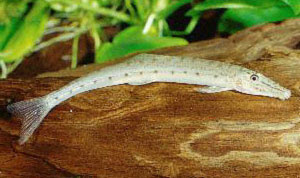| Ortak İsim | At Yüzlü |
| Bilimsel Adı | Acantopsis choirorhynchos |
| Dağıtım | Asya: Hindistan, Myanmar, Tayland, Malezya, Endonezya (Sumatra ve Java), Borneo ve Vietnam |
| Beslenme | Etçil,Otçul. |
| Açıklama | Yumurtalarını saklamaya çalışırlar,ebeveynler yumurtaları yiyebileceğinden ayrılması uygun olacaktır. |
| Mizaç | Barışçıl. |
| Bakım | Karides granül, kan kurdu,solucanlar, yosun gibi çeşitli yiyecekler verilebilir.Bu balıkları en az |
| PH | 6,0-7,0 |
| Sıcaklık | 23 ° C ile 28 ° C |
| Maksimum Boy | |
| Cinsiyet | Erkekler dişilerden daha büyük olur. |
| Üreme | Üretmesi zordur.Deneyim gerektirir. |
| Varyansları | |
| Ana Renkler | Alacalı Gri |
The Horseface Loach Acantopsis choirorhynchos is and interesting aquarium inhabitants that enjoys burrowing. It is also known as the Horsehead Loach and its overall shape is quite suited to its habits. It likes to burrow into the substrate and will sift the sand through its gills in search of microorganisms or other food.
The body of the Horseface Loach is elongated, with a flat belly. The snout is characteristically long and bends downward about halfway between the eyes and nose. It strongly resembles a horse! (go figure) The eyes are covered with a transparent layer and are perched near the top of the head, and slightly protrude from the head. There are no scales on this fish's head. The back and sides of the fish are light brown with various spots and stripes. The lower parts of the fish are white while the fins are brownish.
The Horseface or Horsehead Loach is also sometimes offered as a "Long-nosed Loach" and vice-versa. In actuality, the Long-nosed Loach is a different species, Acantopsis octoactinotos. The two species resemble each other but the Long-nosed Loach is more aggressive (will eat smaller fish like Neon Tetras and Zebra Danios) and is not a burrower.The Long-nosed Loach also does not have the characteristic downturn on its snout.
They have a quiet disposition and make a great community fish.They are generally quite peaceful but they will defend a territory against members of their own species. It is best to keep single fish with other community fish. They enjoy burrowing and should be provided a rounded sand or fine gravel substrate. Provided with the right habitat and a properly maintained aquarium and these hardy fish will reward the aquarist with an interesting and long lived pet.
Care and feeding:Since they are omnivorous, the Horseface Loach will generally eat all kinds of live foods. They like tablets and frozen foods as well, but flake foods are not suggested. Feed brine shrimp (either live or frozen), mosquito larvae, tubifex, daphnia, and some vegetable foods such as algae wafers.
Smaller horseface loaches do fine in a medium sized aquarium (20 gallons or so) with lots of plants and places for retreat such as rocks, caves, and roots. A full grown loach, up to 8 inches , needs a larger 35-45 gallon aquarium. Also use subdued lighting. They do best in soft, slightly acidic water with frequent water changes of about 10% a week. Because they are burrowers, the substrate needs to be a fine gravel or sand that does not have sharp edges. Be sure to provide hardy plants with the roots protected and have decorations firmly placed on the glass bottom so they don't fall over. Plastic tubes also make safe and excellent hiding places.
Distribution:The Horseface Loach Acantopsis choirorhynchos is found in Southeast Asia; Borneo, Burma (Myanmar), Java, Malaysia, Sumatra, Thailand, and Vietnam. They inhabit rapid and slow moving rivers with a sandy or rocky substrate. They are also known as the Horsehead Loach, and are sometimes offered for sale as a "Long-nosed Loach" and vice-versa. The Long-nosed Loach is actually a different species however, Acantopsis octoactinotos.
Size - Weight:These fish can get up to 8.0 inches (20 cm ), they are usually smaller in the aquarium. A 35-45 gallon aquarium is recommened for full grown, 8 inch , horseface loaches
Social Behaviors:A good community fish. They are territorial towards members of their own species. A nocturnal fish, the horseface loach wil usually hide during the day, but are lively and active in the evening.
Water Region: Top, Middle, Bottom:These fish are mostly bottom dwellers, but will occasionally swim in the middle or upper parts of the aquarium.
Acceptable Water Conditions:Hardness: soft water is preferred from 1-10° dH
Ph: 6.0 - 7.0
Temp: 79-84° F (26-29° C)
Ph: 6.0 - 7.0
Temp: 79-84° F (26-29° C)
Breeding/Reproduction:Not much is known about the breeding habits of the Horseface or Horsehead Loach and they are not yet bred commercially.
Animal-World References: Freshwater Fish and Plants
Dr. Rüdiger Riehl and Hans A. Baensch, Aquarium Atlas Vol. 1, Publisher Hans A. Baensch, 1991
Mark in Vancouver, Acantopsis choirorhynchus, Loaches Online, 2009
Acantopsis choirorhynchos (Bleeker, 1854) Horseface loach, Fishbase.org
Bratz Walker, Sharks and Loaches, T.F.H. Publications, Inc., 1974

Hiç yorum yok:
Yorum Gönder